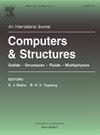Uncertainty quantification of acoustic metamaterial bandgaps with stochastic material properties and geometric defects
IF 4.4
2区 工程技术
Q1 COMPUTER SCIENCE, INTERDISCIPLINARY APPLICATIONS
引用次数: 0
Abstract
Acoustic metamaterials are a subject of increasing study and utility. Through designed combinations of geometries with material properties, acoustic metamaterials can be built to arbitrarily manipulate acoustic waves for various applications. Despite the theoretical advances in this field, however, acoustic metamaterials have seen limited penetration into industry and commercial use. This is largely due to the difficulty of manufacturing the intricate geometries that are integral to their function and the sensitivity of metamaterial designs to material batch variability and manufacturing defects. Capturing the effects of stochastic material properties and geometric defects requires empirical testing of manufactured samples, but this can quickly become prohibitively expensive with higher precision requirements or with an increasing number of input variables. This paper demonstrates how uncertainty quantification techniques, and more specifically the use of polynomial chaos expansions and spectral projections, can be used to greatly reduce sampling needs for characterizing acoustic metamaterial dispersion curves. With a novel method of encoding geometric defects in a 1D, interpretable, resolution-independent way, our uncertainty quantification approach allows for both stochastic material properties and geometric defects to be considered simultaneously. Two to three orders of magnitude sampling reductions down to and were achieved in 1D and 7D input space scenarios, respectively. Remarkably, this reduction in sampling was possible while preserving accurate output probability distributions of the metamaterial performance characteristics (bandgap size and location).
具有随机材料特性和几何缺陷的声学超材料带隙的不确定性量化
声学超材料的研究和应用日益广泛。通过设计几何形状与材料特性的组合,声学超材料可以任意操纵声波,应用于各种领域。尽管在这一领域取得了理论上的进步,但声学超材料在工业和商业应用中的渗透却十分有限。这主要是由于难以制造与其功能密不可分的复杂几何形状,以及超材料设计对材料批次变化和制造缺陷的敏感性。要捕捉随机材料特性和几何缺陷的影响,需要对制造的样品进行经验测试,但随着精度要求的提高或输入变量数量的增加,这种测试很快就会变得昂贵得令人望而却步。本文展示了如何利用不确定性量化技术,特别是多项式混沌展开和频谱投影,来大大减少表征声学超材料频散曲线的采样需求。我们的不确定性量化方法采用了一种新颖的方法,以一维、可解释、与分辨率无关的方式对几何缺陷进行编码,可同时考虑随机材料特性和几何缺陷。在 1D 和 7D 输入空间情况下,采样率分别降低了 2 至 3 个数量级,达到 ∼100 和 ∼101。值得注意的是,在减少采样的同时,还保留了超材料性能特征(带隙尺寸和位置)的精确输出概率分布。
本文章由计算机程序翻译,如有差异,请以英文原文为准。
求助全文
约1分钟内获得全文
求助全文
来源期刊

Computers & Structures
工程技术-工程:土木
CiteScore
8.80
自引率
6.40%
发文量
122
审稿时长
33 days
期刊介绍:
Computers & Structures publishes advances in the development and use of computational methods for the solution of problems in engineering and the sciences. The range of appropriate contributions is wide, and includes papers on establishing appropriate mathematical models and their numerical solution in all areas of mechanics. The journal also includes articles that present a substantial review of a field in the topics of the journal.
 求助内容:
求助内容: 应助结果提醒方式:
应助结果提醒方式:


